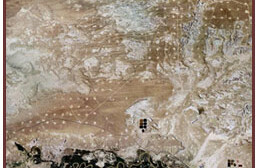This article is part of the Council's second annual SEPTEMBER
SUSTAINABILITY MONTH, which kicks off a year of events and resources
on sustainability. Generous funding of the Carnegie Council's 2010-2011 sustainability
programming has been provided by Hewlett-Packard and by Booz & Company.
Poland and Russia are negotiating the extension of a gas supply deal that could secure Russia's supply of gas to Poland until 2037. Polish Treasury Minister Aleksander Grad said recently that the deal should include flexible long-term conditions, in light of a liquid natural gas pipeline in development and large-scale domestic shale gas deposits.
Poland's shale formations are currently under exploration by ExxonMobil, Chevron, and several other U.S. companies. If the shale gas proves recoverable, it could offset some of Europe's reliance on Russian state-run Gazprom and help the region lower its carbon emissions. According to Environmental Protection Agency (EPA) data comparing the emissions from gas, coal, and oil, natural gas is the cleanest of the fossil fuels. Roughly 96 percent of Poland's electricity is currently supplied by coal-fired plants, and the country ranks in the world's top 25 carbon dioxide emitters, according to U.S. Department of Energy data.
Worldwide, shale gas has been called a "game changer" in terms of its potential impact on energy security and climate policy. The Energy Information Administration (EIA) estimates that shale gas will represent 7 percent of total global gas supply by 2030.
Thanks to shale formations, the United States has reduced its reliance on imported gas over the past two decades and established itself as a gas exporter. U.S. shale gas production has increased eightfold over the past ten years, according to the EIA, and accounts for 20 percent of remaining recoverable gas resources in the United States.
The natural gas boom has brought the promise of job creation, tax revenues, and royalties to states with large shale formations. To date, thousands of wells have been drilled in 34 states to develop shale resources, and companies have offered residents thousands of dollars per acre to lease land and mineral rights.
The Marcellus Shale formation spans 95,000 square miles and several states, from New York to West Virginia. A study conducted by Penn State University predicts that the gas in the Marcellus Shale could be worth $2 trillion and could create more than 180,000 jobs.
Is Hydraulic Fracturing Safe?
Due to horizontal drilling techniques and a process called hydraulic fracturing, or "hydrofracking," removing gas from shale is much more efficient and economically viable than previously thought. Hydrofracking was first used commercially by Halliburton in 1949. The process consists of injecting millions of gallons of fresh water, mixed with sand and chemicals, into the ground at high pressure to create fissures in the rock to release the natural gas.
Range Resources is one of the first and only companies to voluntarily disclose its hydrofracking chemical combination, which many in the industry consider a trade secret. According to Range Resources, chemicals make up 0.05 percent of its injected solution and many are used in toothpaste, contact lens solution, and other everyday products. In concentrated form they are considered hazardous but when diluted they are within acceptable limits.
Among the chemicals commonly used are benzene, toluene, ethylbenzene, and xylenes, all toxic substances. Two of the largest hydraulic fracturing companies, Halliburton and BJ Services, have also admitted to using diesel-based fluids in hydrofracking solutions, in violation of a memorandum of agreement entered into between the EPA and the companies in 2003.
The state of Wyoming requires fracking ingredients to be made public, and several states request disclosure of the chemicals before issuing a drilling permit. The EPA recently requested that nine companies disclose the chemicals used in hydrofracking as part of its two-year investigation of the process.
The EPA investigation follows years of intense criticism of hydrofracking and many claims that the practice contaminates aquifers and groundwater with "fracking" chemicals and petroleum compounds. Complaints and lawsuits have been filed in Louisiana, Pennsylvania, and other shale-rich states over property devaluation, serious illness, and, in one case, the death of 17 cattle that had consumed fracking fluid after it leaked into a pasture during a rainstorm.
Documentarian Josh Fox visited many such sites for his 2010 film Gasland, which depicts property owners lighting their tap water on fire due to its petroleum content. Clearly rendered undrinkable, the offending companies have sometimes paid for enormous plastic cisterns to be installed on these properties to replace the contaminated water supply. Some residents were reluctant to speak to Fox on camera because of nondisclosure agreements signed with the companies.
Protecting the New York City Watershed
Similar fears over contamination of the New York City watershed, which draws from land atop the Marcellus Shale, has led to citizen and political uproar and a de facto drilling moratorium for the past two years. The moratorium was overwhelmingly approved in August by the New York Senate, but a similar bill must be passed by the State Assembly in order for the moratorium to become law. The state hopes to study the situation further and learn from the experiences of Pennsylvania and West Virginia.
The New York drilling moratorium has its own share of critics. A Penn State study predicts that between 2011 and 2020 the halt on drilling will cost New York up to $2 billion in lost tax revenues and more than $11 billion of economic output, when accounting for direct, indirect, and induced business activities that would result from gas company investment in the state. The nonprofit Ground Water Protection Council, made up of state regulatory agencies, has reported no link between ground water contamination and hydrofracking. Companies have insisted that water contamination is the result of human or mechanical error, not the hydraulic fracturing process itself, and would not occur if drilling procedures and protocols were properly followed.
Yet violations of these procedures do commonly occur. Over the past two and a half years, Pennsylvania has issued 1,400 violations to shale drillers, roughly two-thirds of which caused, or had the potential to cause, environmental damage.
Hydraulic fracturing has been regulated on the state level since the 2005 Energy Policy Act exempted the technique from the federal Safe Drinking Water Act and the Clean Water Act. Members of Congress from Colorado, Pennsylvania, and New York are trying to repeal the exemption with the introduction of the Fracturing Responsibility and Awareness of Chemicals Act.
Shale Gas Goes Global
With shale gas reserves being explored on nearly every continent, can U.S. legislation set the tone for regulating the industry overseas?
In November 2009, President Barack Obama reached an agreement with China's Hu Jintao to share U.S. shale gas technology and promote U.S. shale gas investment in China. In April 2010, Secretary of State Hillary Clinton announced proposals to cooperate with Latin America to develop shale gas resources as part of the Energy and Climate Partnership of the Americas.
The U.S. government has launched the Global Shale Gas Initiative to "help countries seeking to utilize their unconventional natural gas resources to identify and develop them safely and economically." Through government-to-government policy engagement, trainings, and public-private sector events, the United States is seeking to share technical expertise and lessons learned on regulation and environmental protection. In addition to China, partnerships have been formed with India and with Poland.
Whether the American shale gas experience can be a model for environmental best practices in other countries is debatable. Professor Terry Engelder of Pennsylvania State University told the Financial Times in an interview this June that industry-wide standards are difficult to enforce because fracking techniques will vary based on geological differences and local conditions surrounding the shale formations. He also said that developing best practices would require industry leaders to "experiment" and that a zero-tolerance policy toward environmental damage is unlikely to be achieved.
If environmental and health problems are considered inevitable side effects of shale gas drilling, municipalities may have a hard time embracing the resource. Amid the global hype, signs of resistance to shale gas development are emerging overseas. Hundreds of South Africans protested the exploitation of the country's Karoo shale reserves, citing concerns over water supply.
Will companies and governments learn to avoid past mistakes and take advantage of shale gas without collateral damage? Will public fear become more widespread and bring exploration and development efforts to a halt? On a global scale, questions remain as to whether shale gas can fulfill its potential as an energy miracle or if it will instead become another resource curse.



